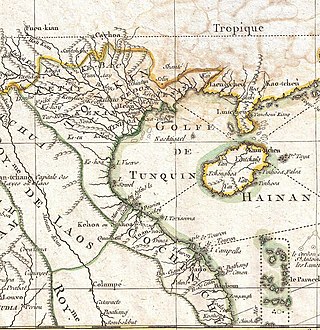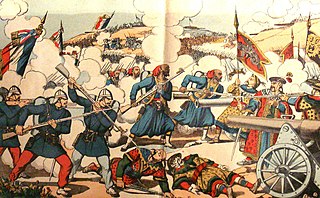
Tonkin, also spelled Tongkin, Tonquin or Tongking, is an exonym referring to the northern region of Vietnam. During the 17th and 18th centuries, this term referred to the domain Đàng Ngoài under Trịnh lords' control, including both the Northern and Thanh-Nghệ regions, north of the Gianh River. From 1884 to early 1945, this term was used for the French protectorate of Tonkin, composed of only the Northern region.
Sino-Japanese War most often refers to:

The Sino-French War, also known as the Tonkin War and Tonquin War, was a limited conflict fought from August 1884 to April 1885. There was no declaration of war. The Chinese armies performed better than in its other nineteenth-century wars and the war ended with French retreat on land and the momentum in China's favor. However lack of foreign support, French naval supremacy, and northern threats posed by Russia and Japan forced China to enter negotiations. China ceded its sphere of influence in Tonkin to France and recognized all the French treaties with Annam, which became a French protectorate. The war strengthened the dominance of Empress Dowager Cixi over the Chinese government, but brought down the government of Prime Minister Jules Ferry in Paris. Both sides ratified the Treaty of Tientsin. According to Lloyd Eastman, "neither nation reaped diplomatic gains."

Liu Yongfu (1837–1917) was a Chinese warlord and commander of the celebrated Black Flag Army. Liu won fame as a Chinese patriot fighting against the French Empire in northern Vietnam (Tonkin) in the 1870s and early 1880s. During the Sino-French War, he established a close friendship with the Chinese statesman and general Tang Jingsong, and in 1895, he helped Tang organise resistance to the Japanese invasion of Taiwan. He succeeded Tang as the second and last president of the short-lived Republic of Formosa.

The Sino-Vietnamese War was a brief conflict that occurred in early 1979 between China and Vietnam. China launched an offensive in response to Vietnam's invasion and occupation of Cambodia in 1978, which ended the rule of the Chinese-backed Khmer Rouge. The conflict lasted for about a month, with China withdrawing its troops in March 1979.

Lạng Sơn is a city in far Northern Vietnam, which is the capital of Lạng Sơn Province. It is accessible by road and rail from Hanoi, the Vietnamese capital, and it is the northernmost point on National Route 1.

Pingxiang (凭祥市) is a county-level city under the administration of the prefecture-level city of Chongzuo, in the southwest of the Guangxi Zhuang Autonomous Region, China.

The Beiyang Fleet was one of the four modernized Chinese navies in the late Qing dynasty. Among the four, the Beiyang Fleet was particularly sponsored by Li Hongzhang, one of the most trusted vassals of Empress Dowager Cixi and the principal patron of the "self-strengthening movement" in northern China in his capacity as the Viceroy of Zhili and the Minister of Beiyang Commerce (北洋通商大臣). Due to Li's influence in the imperial court, the Beiyang Fleet garnered much greater resources than the other Chinese fleets and soon became the dominant navy in Asia before the onset of the 1894–1895 First Sino-Japanese War. It was the largest fleet in Asia and the 8th in the world during the late 1880s in terms of tonnage.

The Japanese invasion of French Indochina was a short undeclared military confrontation between Japan and Vichy France in northern French Indochina. Fighting lasted from 22 to 26 September 1940; the same time as the Battle of South Guangxi in the Sino-Japanese War, which was the main objective as to why Japan occupied Vietnam during this time.
The Indochina Expeditionary Army was an amphibious army corps of the Imperial Japanese Army formed on September 7, 1940 to coordinate the invasion and occupation of French Indochina during the Second Sino-Japanese War. It was supported by a contingent from the Imperial Japanese Navy's IJN 5th Fleet and naval aircraft from the aircraft carrier Hiryū and air bases on Hainan Island.
The Battle of Phu Lam Tao was a politically significant engagement during the Sino-French War, in which a French Zouave battalion was defeated by a mixed force of Chinese soldiers and Black Flags.
The Battle of Hòa Mộc was the most fiercely fought action of the Sino-French War. At heavy cost, Colonel Giovanninelli's 1st Brigade of the Tonkin Expeditionary Corps defeated forces of the Black Flag and Yunnan Armies blocking the way to the besieged French post of Tuyên Quang.

The Lạng Sơn campaign was a major French offensive in Tonkin during the Sino-French War. The Tonkin Expeditionary Corps, under the command of General Louis Brière de l'Isle, defeated the Chinese Guangxi Army and captured the strategically important town of Lạng Sơn in a ten-day campaign mounted under formidable logistical constraints.

The Bắc Lệ ambush was a clash during the Tonkin Campaign in June 1884 between Chinese troops of the Guangxi Army and a French column sent to occupy Lạng Sơn and other towns near the Chinese border. The French claimed that their troops had been ambushed by the Chinese. The incident led to the Sino-French War.

The Kép campaign was an important campaign in northern Vietnam during the opening months of the Sino-French War. A force of just under 3,000 French troops under the command of General François de Négrier defeated a major Chinese invasion of the Red River Delta launched by Pan Dingxin's Guangxi Army in successive engagements at Lâm, Kép and Chũ.

François Oscar de Négrier, known as Oscar de Négrier, was a French general of the Third Republic, winning fame in Algeria in the Sud-Oranais campaign (1881) and in Tonkin during the Sino-French War.

The Tonkin campaign was an armed conflict fought between June 1883 and April 1886 by the French against, variously, the Vietnamese, Liu Yongfu's Black Flag Army and the Chinese Guangxi and Yunnan armies to occupy Tonkin and entrench a French protectorate there. The campaign, complicated in August 1884 by the outbreak of the Sino-French War and in July 1885 by the Cần Vương nationalist uprising in Annam, which required the diversion of large numbers of French troops, was conducted by the Tonkin Expeditionary Corps, supported by the gunboats of the Tonkin Flotilla. The campaign officially ended in April 1886, when the expeditionary corps was reduced in size to a division of occupation, but Tonkin was not effectively pacified until 1896.
The Retreat from Lạng Sơn was a controversial French strategic withdrawal in Tonkin at the end of March 1885 that brought down the government of the French premier Jules Ferry and brought the Sino-French War to an end under conditions that were considered humiliating for France.

The Tonkin Expedition commemorative medal was awarded to all the French soldiers and sailors who took part in the battles of the Tonkin campaign and the Sino-French War between 1883 and 1885. The medal, decreed by a law of 6 September 1885, was minted at the Monnaie de Paris and distributed shortly before the Bastille Day parade on 14 July 1886 to around 65,000 soldiers and sailors. The medal was later awarded to participants in a number of earlier and later campaigns in Indochina, bringing the total number of recipients to 97,300.
Events in the year 1885 in China.













